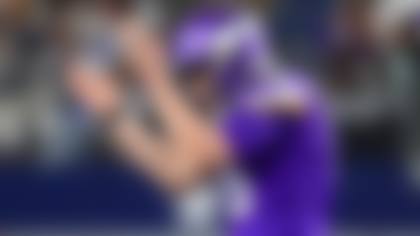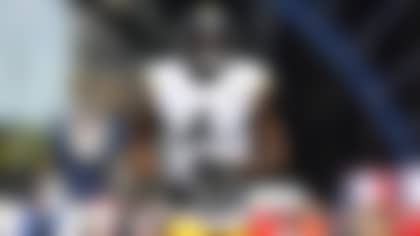New Chargers quarterbacks coach Pep Hamilton has yet to meet Justin Herbert in person, but the veteran assistant believes he has a pretty good feel for Los Angeles' top draft pick.
"I know that he's really smart, physically off the charts, and football is very important to him," Hamilton said following the team's virtual rookie minicamp over the weekend. "He wants more. He wants to know the why in everything you ask him to do. He wants to really understand and digest the conceptual reasoning behind different plays and what the defense is doing."
Hamilton, who has worked with quarterbacks as a position coach or coordinator on the pro or college level for all but four years of his 24-year career, has one of the most important jobs on the Bolts' staff: developing Herbert, who was drafted sixth overall with the expectation that he will replace the departed Philip Rivers as the face of the franchise and the leader of the offense.
Hamilton has experience with such situations. In 2013, he left Stanford to become offensive coordinator of the Indianapolis Colts, who wanted him to oversee the development of Andrew Luck, the first pick of the 2012 NFL Draft. Hamilton had coached Luck in college and knew him athletically as well as anyone. In Year 2 of their three seasons together in the NFL, Luck threw for 4,761 yards and 40 touchdowns, numbers that rank as personal highs for his seven-year career.
"One of the things I learned from that experience was, sometimes you have to protect young quarterbacks from themselves," Hamilton said.
In the case of Luck, that meant reinforcing the importance of not taking hits. At 6-foot-4, 240 pounds, the bearded baritone liked to take on defensive backs in the open field -- which was OK in isolation, but became problematic when compounded over time. Hamilton figures to reinforce that lesson with the 6-6, 236-pound Herbert at some point.
For now, though, Hamilton wants to protect the Chargers rookie by educating him on the fundamentals of reading NFL defenses, which are more sophisticated and talented than what Herbert saw in college. One of the coach's favorite sayings is, "When you see a little, you see a lot. And when you see a lot, you don't see anything."
Translation: A quarterback should not be distracted by all 11 defenders before the snap of the ball; he should be locked in on one or two defenders who, based on their ultimate alignment, will tell him what the pass coverage is and where the holes in the defense will be. Additionally, there are other things that need to be mastered at the same time, little details that can be critical to success, like not looking down at the snap of the ball.
"The layman can tell you that when you're looking at the back of the center, you're not looking up at the defense and the picture could change," Hamilton said. "So that's the obvious reason to have your eyes up. But truly, when you're going through your cadence and scanning the defense, when you look down, you're telling the defense that the ball is about to be snapped, and that could give defenders a split-second advantage at get-off."
These days, Hamilton and Herbert communicate by phone and online video conference. Hamilton is social distancing from his home in Michigan, and Herbert disclosed this week that he has moved from the Pacific Northwest to Southern California, where he is working with John Beck and Tom House, a motion mechanics instructor and a motion performance expert, respectively. Besides addressing the intricacies of throwing the football, they also are working on the necessary footwork for dropping back from under center. Herbert rarely did that at Oregon, where the Ducks operated almost exclusively out of the shotgun.
While it might seem simple to an outsider to take five- and seven-step drops from under center, Hamilton says it's like going from riding a bike all your life to suddenly jumping on a unicycle.
"It's different. It takes time," he said. "You still have to balance yourself, but it's a different sensation."
Another reason for Herbert to become proficient under center is that it expands the run game. Certain concepts in the stretch zone become eliminated when the running back offsets to one side. So unless you have designed runs for your QB, like the Baltimore Ravens with Lamar Jackson, a team's ground attack will be more limited if it works almost exclusively from the shotgun. And one thing we know about Chargers head coach Anthony Lynn is that he wants to be able to run the football, particularly in the final four minutes of the fourth quarter.
"When you're under center, you have access to the entire run tree," Hamilton said.
The fact remains that Herbert was drafted for his ability to throw the football. He has tremendous arm strength and is unafraid of pushing the ball downfield. Equally important for the Chargers is that he takes care of the ball, throwing just 22 interceptions in 1,293 career attempts. Rivers averaged nearly 16 interceptions over his final six seasons, twice tossing at least 20 during that time.
Hamilton did not spend time scouting Herbert last year because Hamilton was coaching Washington's XFL franchise, and there was no way Herbert was going to wind up in the fledgling league. But he did watch his performance against Stanford, which maintains a special place in Hamilton's heart. All Herbert did in the 21-6 victory was complete 19 of 24 passes for 259 yards and three touchdowns with no interceptions.
"There was no doubt he was the best player on the field that day," Hamilton said.
It's uncertain when Herbert and other players will be able to get on the field due to the COVID-19 pandemic, so in the meantime he'll continue to have regular virtual sessions with Hamilton. To that end, Hamilton went back and studied the offense Herbert ran in college, then debriefed the player on the terminology that was used for certain plays. The goal was to be able to show Herbert conceptually the correlation between what he did in college and what the Chargers are asking him to do. For instance, a four-vertical route might have been called "red" in college -- that's a made-up term -- but in Los Angeles, it's called "green."
"You read it the same, the routes are the same, but we call it 'green' as opposed to 'red,' " Hamilton said. "That helps him to paint a picture. And with quarterbacks, it's really about just hearing a play and having an image of where guys are going to be, then applying that to what the defense is playing and where guys are going to be. It helps in the decision-making.
"At this point, I'm looking forward to getting more feedback from Justin. Right now, we're in lecture mode. Our sessions are interactive, but it's more so testing him on the things that we've introduced and seeing, Does he have a recall? The answer is: Yes, he does. He's a guy who can memorize a lot of information in the short term and in the long term. We already know he can really throw the football. I haven't coached a quarterback that just had the natural release and spin on the ball that Justin has since Vinny Testaverde -- a tall, linear guy, a long-levered guy who really just has a great release and can make all the throws."
For now, Hamilton can only admire that release on tape, but he's not fretting because there is a lot of work to do while waiting to get on the field.
Follow Jim Trotter on Twitter https://twitter.com/JimTrotterNFL_" target="blank">@JimTrotter_NFL.












